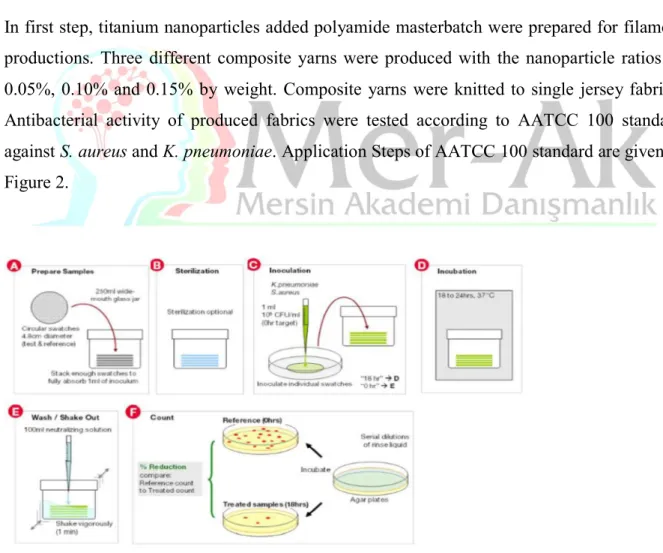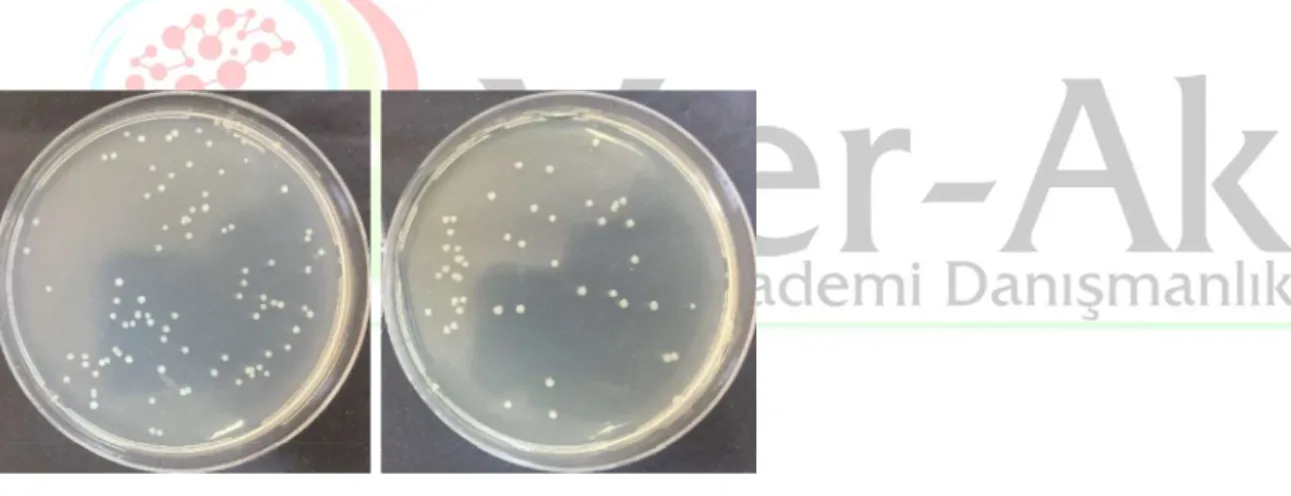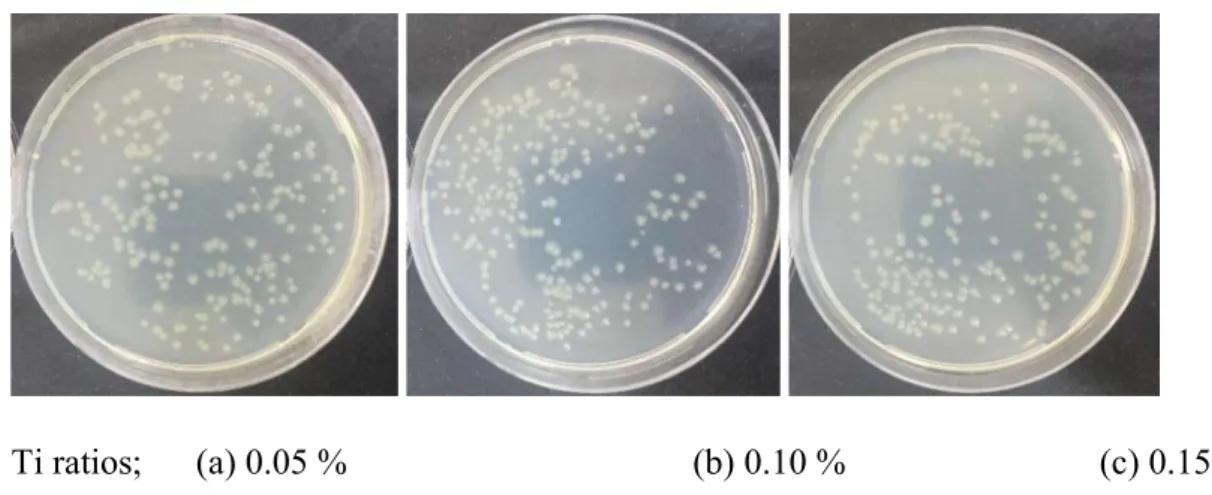INVESTIGATION OF ANTIBACTERIAL ACTIVITY OF KNITTED FABRICS PRODUCED FROM NANO TITANIUM DOPED POLYAMIDE YARNS
47
ABSTRACT
In this study, antibacterial activities of plain knitted fabrics produced from titanium nanoparticles containing polyamide yarns were investigated. For this purpose, titanium nanoparticles were added to the polymer at a rate of 0.05 - 0.10 - 0.15% by weight, and 3 different yarns were produced. Plain knitted fabrics were produced using these yarns. Antibacterial activity test was applied to knitted fabrics according to AATCC 100 standard. S. aureus and K. Pneumoniae bacteria were used in the tests. As a result of the study, it was found that the nano titanium additive at the mentioned ratios did not provide an effective antibacterial property to the fabrics.
Key Words: Antibacterial activity, Nano particle, Knitted Fabric, Titanium
antibakteriyel aktiviteleri ar - 0,10 - S. aureus ve K. Pneumoniae in bir Anahtar Kelimeler 47 -mail: iozkan@cu.edu.tr
INTRODUCTION
Bacterial infections produce risks in public places such as kindergartens, schools, mosques, hospitals etc. Textile materials, whether natural or synthetic, do not exhibit natural resistance to bacteria. So, various techniques are used for developed antibacterial textiles. Antimicrobial yarns can be produced by adding antibacterial substances into the structure. In general, textile products manufactured from antibacterial yarns permanently have this feature. General production technologies of antimicrobial fiber are given in Figure 1.
Figure 1. (a) Physical incorporation (b) surface application (c) chemical bonding of reactive groups of fiber (Uddin, 2010).
Internal antimicrobial release: a viable option for synthetic fibres, where antimicrobials can be incorporated into the fibres when they are spun.
Surface application: applicable to all fibres. The washing durability depends on material affinity. Surface application may interfere with textile handling properties.
Chemical bonding: the best way to achieve durability. It requires suitable reactive groups on the textile (Uddin, 2010).
In previous studies, various metallic and chemical additives were used for gaining antimicrobial activity to the fabrics. Nano silver is one of the most used additives among these materials for providing the durable antibacterial activity in a broad antibacterial spectrum (Lee, et al., 2003; Jeong, et al., 2005; Topp, et al., 2014; Raza et al., 2015; Balakuraman et al.,
2016; Khude et al., 2018). Similarly, Titanium (Ti) is used in clinical applications as metal component. In addition, some merit of TiO2-NTs can be used as carriers for antibacterial agents such as silver (Zhao et al., 2011). In textile research, especially TiO2 preferred as
antibacterial agent (Kangwansupamonkon et al., 2009; Parthasarathi, 2009; Montazer et al., 2011).
In this study, antibacterial activity of knitted fabrics which produced by Ti nano particles doped polyamide yarns were investigated. For this purpose, antibacterial activity of knitted fabrics that include 0.05%, 0.10% and 0.15 % Ti nanoparticle were tested according to AATCC 100 standard and results were evaluated.
MATERIAL AND METHOD
In first step, titanium nanoparticles added polyamide masterbatch were prepared for filament productions. Three different composite yarns were produced with the nanoparticle ratios of 0.05%, 0.10% and 0.15% by weight. Composite yarns were knitted to single jersey fabrics. Antibacterial activity of produced fabrics were tested according to AATCC 100 standard against S. aureus and K. pneumoniae. Application Steps of AATCC 100 standard are given in Figure 2.
Figure 2. Application of AATCC 100 standard (Height M., 2019)
R (%) = 100 (B A)/B (1)
Where; R is the percentage reduction ratio, A is the number of bacteria recovered from the inoculated treated test specimen swatches in the jar incubated over the 24 hours contact period, and B is the number of bacteria recovered from the inoculated treated test specimen swatches in the jar immediate
RESULT AND DISCUSSION
Petri dishes photos for S. aureus and K. pneumonia
S. aureus K. pneumoniae
Figure 4. Petri dishes photos for S. aureus and K. pneumonia at
Ti ratios; (a) 0.05 % (b) 0.10 % (c) 0.15 % Figure 4. Petri dishes photos knitted fabrics for K. pneumoniae after 24 hours contact time
Petri dishes photos for S. aureus after 24 hours contact time are given in Figure 5.
Ti ratios; (a) 0.05 % (b) 0.10 % (c) 0.15 %
Figure 5. Petri dishes photos of knitted fabrics for S. aureus after 24 hours contact time
When Figure 3, 4 and 5 evaluated together, it can be seen that the number of bacterial colonies increased at the end of 24 hours contact times. It can be said that the composite samples including 0.05%, 0.10% and 0.15% Ti nanoparticles were not show antibacterial activity against for S. aureus and K. pneumonia.
CONCLUSION
In this research, antibacterial activity of knitted fabrics which produced by Ti nano particles doped polyamide yarns were investigated. For this purpose, antibacterial activity of knitted fabrics that include 0.05%, 0.10% and 0.15 % Ti nanoparticle were tested according to AATCC 100 standard and results were evaluated. According to results, % 100 Ti participles did not provide antibacterial activity to the knitted fabrics at the used ratios of 0.05%, 0.10% and 0.15 %. Zhao et al., noted that the pure titanium could not prevent the growth of S. aureus Titanium components can be used for effective antibacterial activity instead of pure titanium. In addition, the use of titanium as a carrier for antibacterial agents can be provide more effective antibacterial activity.
REFRENCES
1. Jalal Uddin A. (2010). Technical Textile Yarns: Part 9 - Novel technical textile yarns, Woodhead Publishing, Pages 259-297.
2. Lee H. J., Yeo S. Y., Jeong S. H. (2003). Antibacterial Effect of Nanosized Silver Colloidal Solution on Textile Fabrics, Journal of Materials Scince, 38: 2199 2204. 3. Jeong, S. H., Yeo, S. Y., YI, S. C. (2005). The Effect Of Filler Particle Size On The
Science, Polymer Fibres, 40: 5407 5411.
4. Topp, K., Haase, H., Degen, C., Illing, G. and Mahltig, B. (2014). Coatings With Metallic Effect Pigments For Antimicrobial and Conductive Coating of Textiles With Electromagnetic Shielding Properties, Journal of Coatings Technology and Research, 11(6): 943-957.
5. Raza, Z. A., Rehman, A., Mohsin, M., Bajwa, S. Z., Anwar, F., Naeem, A., & Ahmad, N. (2015). Development of antibacterial cellulosic fabric via clean impregnation of silver nanoparticles. Journal of Cleaner Production, 101, 377-386.
6. Balakumaran, M. D., Ramachandran, R., Jagadeeswari, S., & Kalaichelvan, P. T. (2016). In vitro biological properties and characterization of nanosilver coated cotton fabrics An application for antimicrobial textile finishing. International biodeterioration & biodegradation, 107, 48-55.
7. Khude, P., Majumdar, A., & Butola, B. S. (2018). Leveraging the Antibacterial Properties of Knitted Fabrics by Admixture of Polyester-Silver Nanocomposite Fibres. Fibers and Polymers, 19(7), 1403-1410.
8. Kangwansupamonkon, W., Lauruengtana, V., Surassmo, S., & Ruktanonchai, U. (2009). Antibacterial effect of apatite-coated titanium dioxide for textiles applications. Nanomedicine: Nanotechnology, Biology and Medicine, 5(2), 240-249.
9. Parthasarathi, P., & Thilagavathi, G. (2009). Synthesis and characterization of titanium dioxide nano-particles and their applications to textiles for microbe resistance. Journal of Textile and Apparel, Technology and Management, 6(2): 1-8.
10.
dioxide on textiles: Antifelting and antibacterial wool. Journal of Applied Polymer Science, 121(6), 3407-3413.
11. Zhao, Q. M., Li, G. Z., Zhu, H. M., & Cheng, L. (2017). Study on Effects of Titanium Surface Microporous Coatings Containing Zinc on Osteoblast Adhesion and Its Antibacterial Activity. Applied bionics and biomechanics. 1-4.
12. Height M., www.microbe-investigations.com/testing-methods/aatcc-100, Last access date: 23.05.2019.


